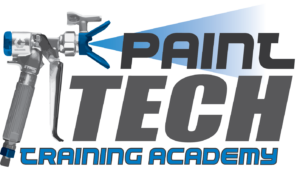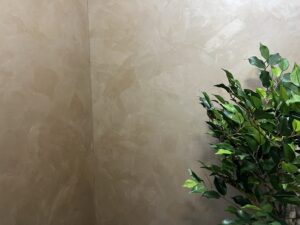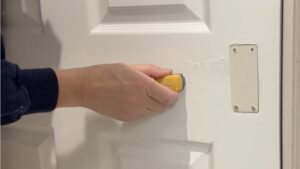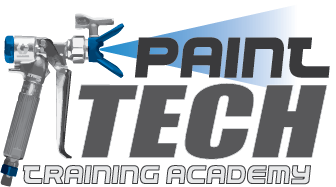Do you spray kitchens already or hand paint them..
- Would you spray kitchens if you had the confidence to do so?
- Are you worried about overspray?
- Are you worried about masking?
- Don’t know where to start with what tip size or pressure?
These are just some of the questions that we get asked about A LOT!
For years now clients have asked us to paint their kitchens and this is often for many reasons: it’s looking tired, it’s the wrong colour, it’s been damaged or I just want to change the look. Mostly though it’s because painting an existing kitchen is often much cheaper than having a whole new one fitted and is the reason that most clients chose this option..
We have been painting kitchens and fitted furniture on site for 20 years but to be honest, more often than not we were asked to hand paint them. I think this was partly because the clients didn’t realise spraying was an option but mostly because spraying in someones home wasn’t even a consideration because spraying was considered for the more commercial larger projects.
Hand Painted Kitchens
Although we always achieved a great finish we had to use some clever marketing and would use words like charming or hand crafted to describe an elegant hand painted finish. We worked with a successful kitchen company and painted all of their kitchens so have done quite a few to date!
But I have always felt that if you wanted the ULTIMATE finish then you would have it sprayed. The problem with this was that the doors would need to be removed and sprayed in a workshop then returned and re fitted on site. This left a dilemma as to what we would do about the end panels, plinths and cornice? Yes it meant hand painting them which really defeated the object of a sprayed finish.
So, why not to spray!
Because there will be a right mess with all the overspray that is created by the spray machine!
Or will there??
How do we do it? We have designed and developed systems over the years to allow us to be able to spray and get incredible finishes in clients homes time and time again! What people don’t realise is that it is all about systems – it’s about how you protect the area & how you cover everything that isn’t getting painted. It’s about using the right masking tapes, papers and plastics but using them in the right way and the right combination for it to work well.
Most decorators are only interested in getting the job done and don’t have a system for anything. They don’t make notes either; when we started we wrote down what project we are on, what product we are using, what machine, what tip size & what pressure. This meant that when we are on a similar project or using the same product again we can refer to the notes which give us a starting point. By having systems and a plan you will save a huge amount of time and have much less frustration.
Masking is the biggest factor for most people and is often something that just puts people off. It’s not hard but it does take practice when you start and you will make mistakes. At the end of the day it is just part of doing business..
We put together a masking course to make life easier for people wanting to learn about masking which can be found here.
To achieve the best finish it’s the whole system you need.. It’s masking correctly, preparing the units, choosing the right product, machine, tip and pressure all combined together. BUT most importantly it’s about technique…
What machine do I need to spray a kitchen?
To be fair there is a lot of choice on the market at the moment and more machines keep coming! It can be really confusing to work out what will be best for you and the kind of work you do.
When you do come to deciding on which machine to buy some things to think about are:
- What work you are doing now?
- What work you are looking at in the future?
- What size projects are you doing or thinking of doing?
- Is your budget realistic?
What machines are there to chose from?
You can use a compressor, HVLP, Airless or Air Assisted Airless – all of them will deliver a fantastic finish but they all work slightly differently.
Once you know how to get the best out of your machine then the next thing to think about is choosing the right primers and paints as not all paint spray as well as others.!
Can all paints be sprayed?
Yes and No.. You can spray almost any paint yes, but will it deliver a great finish – No! Why? Simply put not all paints are formulated to be atomised by a sprayer.
What size tip and how much pressure do I need?
This is always the golden question we get asked and like life, there is no golden answer. It is about finding the sweet spot, it’s something that you have to work at but it does get easier the more you do. It’s about perfecting the combination or product, tip and pressure to get the best results but this can vary even if the same combination was used each time. This can be down to temperature of the surrounding or the paint and also the humidity and this is why there is no golden answer. Find a combination that works well for you and work at it from there.
Having the knowledge to know where to start is key as finding the best parameters will get you there much quicker and easier.
What advice could you give me?
I have had lots of good decorators ask me for advice spraying kitchens and my reply is based on the answer to a few questions first. Things like what sprayer do you have, what paint are you spraying, what size tip and filter are you going to use, what pressure are you thinking of and then the final one “have you sprayed kitchens or fitted furniture before”? Depending on the answers the majority of the time I tell them simply – don’t do it! They are inevitably going to have problems which cannot mean a good outcome for either them or the client.
So what should I do?
Gain more knowledge and experience first. HOW? Well there are loads of places on the internet, on youtube or do training.
We have a furniture & joinery course which focuses on spraying on site with water based systems. This course runs through everything from start to finish including prep, masking, removing doors & spraying techniques.
Why bother with training?
Well you don’t have to; you can always learn on the job like we did!! BUT we paid the price so you don’t have to.
We have made all the mistakes over the years, found the pitfalls, lost time & money but most importantly the confidence.
Surely its much quicker, easier and cheaper to learn from someone who has mastered the systems and is prepared to share them, someone who is still working on projects now within their own business! We want you to mess it all up at the academy, have problems and issues with us around so that we can show and teach you how to rectify and solve the problems so that when you start the project you know how to get over most of the issues.
Sound scary?
Good, because if it was that easy everyone would be spraying kitchens on site!
However it’s not when you master it well and you will be in a whole different league.
You can now offer a service that way above all the other competition for loads of benefits:
The finish is far better and I mean a LOT better. It looks solid with a higher lustre without any brush marks or construction lines – it’s how its meant to look .. its best!
Save a ton of time. A simple question you to ask your client – What would you say I said to you that your kitchen will not be fully operational for 2 weeks, in most busy households that would be a nightmare. However if you chose me to paint it I can turn it around within a week with minimal mess and disruption.
In short you can now offer a service that is far better than your competiton and a huge benefit to your clients which of course in turn has a massive impact on referrals levels which makes finding bigger and better work far easier.
So does Spraying Kitchens Make Sense?
There is a massive fear of the spray machines and to be fair there should be because when things go wrong with a sprayer they go wrong at 1500psi or more without training. That means everything is going to get covered in paint including the cat!





